
The Electoral Palatinate or the Palatinate, officially the Electorate of the Palatinate, was a state that was part of the Holy Roman Empire. The electorate had its origins under the rulership of the Counts Palatine of Lotharingia in 915; it was then restructured under the Counts Palatine of the Rhine in 1085. From 1214 until the Electoral Palatinate was merged into the Kingdom of Bavaria in 1805, the House of Wittelsbach provided the Counts Palatine or Electors. These counts palatine of the Rhine would serve as prince-electors from "time immemorial", and were noted as such in a papal letter of 1261; they were confirmed as electors by the Golden Bull of 1356.

The Rhineland is a loosely defined area of Western Germany along the Rhine, chiefly its middle section.
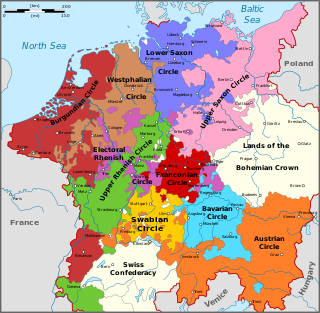
During the early modern period, the Holy Roman Empire was divided into imperial circles, administrative groupings whose primary purposes were the organization of common defensive structure and the collection of imperial taxes. They were also used as a means of organization within the Imperial Diet and the Imperial Chamber Court. Each circle had a circle diet, although not every member of the circle diet would hold membership of the Imperial Diet as well.

The Catholic League was a coalition of Catholic states of the Holy Roman Empire formed 10 July 1609. While initially formed as a confederation to act politically to negotiate issues vis-à-vis the Protestant Union, modelled on the more intransigent ultra-Catholic French Catholic League (1576), it was subsequently concluded as a military alliance "for the defence of the Catholic religion and peace within the Empire".

An Imperial State or Imperial Estate was a part of the Holy Roman Empire with representation and the right to vote in the Imperial Diet. Rulers of these Estates were able to exercise significant rights and privileges and were "immediate", meaning that the only authority above them was the Holy Roman Emperor. They were thus able to rule their territories with a considerable degree of autonomy.
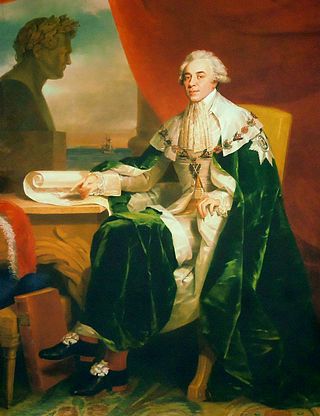
Count Nikolai Petrovich Rumyantsev, born in Saint Petersburg, was Russia's Foreign Minister and Chancellor of the Russian Empire in the run-up to Napoleon's invasion of Russia (1808–12). He was the son of Field Marshal Pyotr Rumyantsev-Zadunaisky from the Rumyantsev comital family.

The Prince-Bishopric of Speyer, formerly known as Spires in English, was an ecclesiastical principality in what are today the German states of Rhineland-Palatinate and Baden-Württemberg. It was secularized in 1803. The prince-bishop resided in Speyer, a Free Imperial City, until the 14th century, when he moved his residence to Uddenheim (Philippsburg), then in 1723 to Bruchsal. There was a tense relationship between successive prince-bishops, who were Roman Catholic, and the civic authorities of the Free City, officially Protestant since the Reformation. The prince-provostry of Wissemburg in Alsace was ruled by the prince-bishop of Speyer in a personal union.

The Austrian Circle was an Imperial Circle of the Holy Roman Empire. It was one of the four Imperial Circles created by decree after the 1512 Diet at Cologne, twelve years after the original six Circles were established in the course of the Imperial Reform. It roughly corresponds to present-day Austria, Slovenia, and the Trentino-Alto Adige/Südtirol and Venezia Giulia regions of Northern Italy, but also comprised the Further Austrian territories in the former Swabian stem duchy.
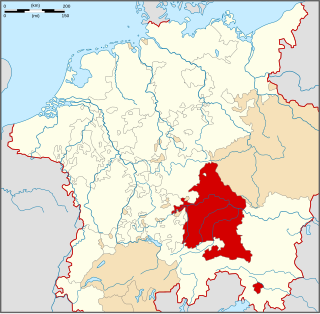
The Bavarian Circle was an Imperial Circle of the Holy Roman Empire.

The Franconian Circle was an Imperial Circle established in 1500 in the centre of the Holy Roman Empire. It comprised the eastern part of the former Franconian stem duchy—roughly corresponding with the present-day Bavarian Regierungsbezirke of Upper, Middle and Lower Franconia—while western Rhenish Franconia belonged to the Upper Rhenish Circle. The title of a "Duke of Franconia" was claimed by the Würzburg bishops.
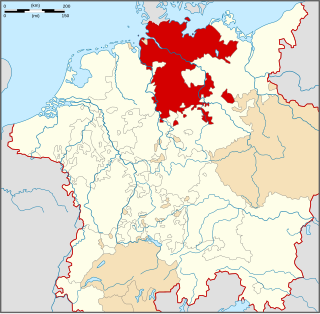
The Lower Saxon Circle was an Imperial Circle of the Holy Roman Empire. It covered much of the territory of the medieval Duchy of Saxony, and was originally called the Saxon Circle before later being better differentiated from the Upper Saxon Circle by the more specific name.

The Upper Saxon Circle was an Imperial Circle of the Holy Roman Empire, created in 1512.
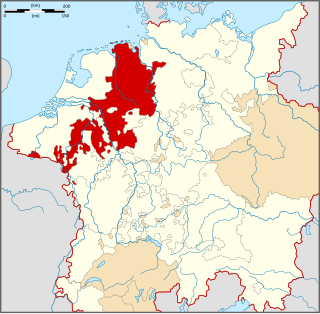
The Lower Rhenish–Westphalian Circle was an Imperial Circle of the Holy Roman Empire. It comprised territories of the former Duchy of Lower Lotharingia, Frisia and the Westphalian part of the former Duchy of Saxony.
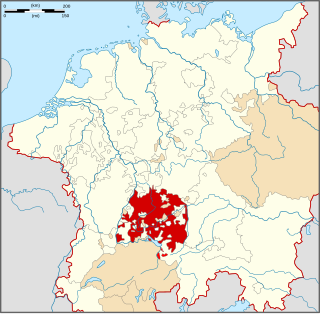
The Circle of Swabia or Swabian Circle was an Imperial Circle of the Holy Roman Empire established in 1500 on the territory of the former German stem-duchy of Swabia. However, it did not include the Habsburg home territories of Swabian Austria, the member states of the Swiss Confederacy nor the lands of the Alsace region west of the Rhine, which belonged to the Upper Rhenish Circle. The Swabian League of 1488, a predecessor organization, disbanded in the course of the Protestant Reformation and the Thirty Years War later in the 16th century.

The Upper Rhenish Circle was an Imperial Circle of the Holy Roman Empire established in 1500 on the territory of the former Duchy of Upper Lorraine and large parts of Rhenish Franconia including the Swabian Alsace region and the Burgundian duchy of Savoy.

Cambrésis is a former pagus, county and prince-bishopric of the medieval Holy Roman Empire that was annexed to the Kingdom of France in 1679. It is now regarded as one of the "natural regions" of France, and roughly equivalent to the Arrondissement of Cambrai in department Nord. The capital of Cambrésis was Cambrai. Originally ruled by a dynasty of counts, Cambrésis became a prince-bishopric in 1007, comparable to the Prince-Bishopric of Liège and the Prince-Bishopric of Utrecht. It encompassed the territory in which the bishop of Cambrai had secular authority.

The Imperial Diet was the deliberative body of the Holy Roman Empire. It was not a legislative body in the contemporary sense; its members envisioned it more like a central forum where it was more important to negotiate than to decide.

When the Imperial Circles — comprising a regional grouping of territories of the Holy Roman Empire — were created as part of the Imperial Reform at the 1500 Diet of Augsburg, many Imperial territories remained unencircled.




















